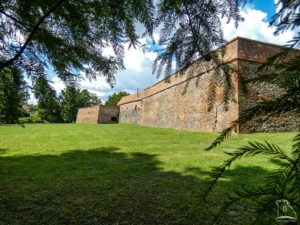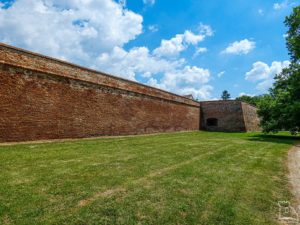Sárvár

The so-called Nádasdy castle of Sárvár is located in the western part of Hungary, it used to be an important fort of the Borderland during the Ottoman wars. The area around Sárvár has been inhabited since prehistoric times. The provinces of the Western Roman Empire were occupied by the Germans, and Pannonia was occupied in 433 AD by the Huns of Attila. After the death of Attila, the Empire disintegrated, and the area became the land of the Eastern Goths, then the Gepids, and Longobards took their place.

From the second part of the 6th century, it became the realm of the Avars. The rule of the Avars was overthrown by the Frank Emperor Charles the Great in 796, and Transdanubia was annexed to its Empire. Soon, Slavs settled here, and a small state was established around Zalavár. During the Hungarian conquest in the 9th century, this area was occupied by the tribe of Lél and Vérbulcsú, who built an earthen castle on the site of today’s old vineyard to protect it. It was a castle of mud, clay, and palisade at the confluence of the Gyöngyös and Rába rivers. In fact, Sárvár means “mud castle” in the Hungarian language.

The inner castle was surrounded by a deep ditch, into which water could be quickly drained from the nearby Gyöngyös river in case of peril. The east side of the Old Castle was 140, the south 250, the west 200, and the north 240 steps long, so the circumference of the castle was 830 steps in total. The castle was surrounded by a rampart. The old name of the castle was Black Castle aka “Castrum nigrum” or “Vignitia”.

The castle of Sárvár was mentioned first in 1192. In the southwestern part of the castle, some wall remains from the 13th century were found, probably joined by a three-story tower. Presumably, there may have been buildings built of wood and beams inside the castle. In 1273, King László IV donated it to the Ják Clan. Then, the kings owned it until 1280 when the Kőszegi family got it and held it until 1327.

King Károly Róbert restored the former rights in 1327, which showed that in the first two decades, Sárvár had been a royal castle. Then, it was recaptured by Köcski Sándor from the Németújvár family. (Note, I use the Oriental name order for Hungarian names where family names come first.)
In 1390, King Sigismund donated Sárvár with his accessories along with the castle of Léka castle to Archbishop Kanizsai János of Esztergom and his brother, together with the market towns of Csepreg and Szigeth and their accessories.

Sárvár’s castle captain was appointed by the Kanizsai family in the early 1400s. He was Egervári Mihály, who received a permit from Sigismund / Zsigmond in 1402 to build a castle on his estate called Franciska. Due to the infidelity of the Kanizsai, the king took Sárvár from the Kanizsai family by a siege in 1403 and donated it first to the Garai family, and then in 1411 to Philippo Scolari (Pipó of Ozora), a faithful man of the king of Florentine origin.
However, Lord Pipo soon bartered Sárvár castle. With a charter dated June 24, 1424, King Sigismund confirmed the exchange agreement, according to which Ozorai Pipó, Chief of Temesvár (Timisoara), exchanged the castle of Sárvár with all his estates for the castle of Simontornya and its accessories for Kanizsai István and János.

During the 15th century, the Kanizsai family had retaken it and lost it several times. When the castle was in their hands, major constructions were carried out. The name of this family is associated with the expansion of the residential area, the palace, and the commencement of the construction of the gate tower that can still be seen today.

After the death of Kanizsai László, Chief of the County of Vas, his daughter, Orsolya, inherited the huge estate and moved here with her aunt, Dorottya. It happened here, in Sárvár that Nádasdy Tamás married Orsolya, who was only 14 years old, in 1532, and Sárvár fell into his hands through this marriage. The management of the estate was taken over by his father Nádasdy Ferenc. The Turks laid an unsuccessful siege on it in the same year, and we know that one hundred defenders died during the few-day-long fight.

The new owner, Nádasdy Tamás, continued the construction in the Renaissance style, in the 16th-17th centuries. He had formed the protective belt of the closed courtyard, with a pentagonal floor plan, made of stone and brick, along with the bastions built according to the Old Italian fashion. This protective belt with its earth bastions is visible today. Their material was coming from the deepening of the moats around the castle. Nádasdy Tamás also established a printing house in Sárvár, along with a school in 1537. At Nádasdy’s invitation, Sylvester János arrived at Sárvár in 1534, after his study trip to Wittenberg, published his first Hungarian language book “Grammatica Hungaro-Latina” in 1539, and 1541 a translation of the “New Testament” that was later printed in Sárvár.

A bridge led to the entrance to the moat, which was completed by 1552. The foundations of the gate tower were reinforced with a palisade in 1560, at which time the drawbridge was also built. Nádasdy’s name is associated with the Renaissance open corridor built in front of the Gothic building of the eastern palace wing, with the row of arcades on the ground floor.

Due to the Nádasdy family, the castle of Sárvár, now called Nádasdy Castle, played a significant role in the progress of Hungarian culture in the 16th and 17th centuries. For example, Tinódi Lantos Sebestyén, the great poet and lutist, came to Sárvár in 1545 and died there in 1556.
The construction of the castle was presumably completed in 1559. Further reinforcement of the castle began in 1588 when Nádsdy Ferenc began to rebuild the old wooden and earth castle from stone. His work was completed in 1615 by his son Pál. Brick and natural stone walls were built barely 1-2 meters in front of the old walls and bastions, also in the Old Italian fashion.

Nádasdy died of the plague in 1562, and although three sons were born from his marriage, only one, his heir Ferenc II, who was later referred to as the “Black Bey”, reached adulthood. Ferenc was a famous and strong warrior, and also the Judge of the Country. The knight’s hall of the castle (see above) is decorated with the battle scenes of the Black Bey (married to Báthory Elizabeth / Erzsébet) and with scenes from the Old Testament. Here is my article about the falsely accused Lady Báthory Erzsébet:
https://www.hungarianottomanwars.com/essays/lady-bathory-erzsebet-1560-1614/

As for the Black (or “strong”) Bey, already at the age of 22, he was awarded the title of Chief Captain of the kingdom and led successful campaigns against the Ottomans. Also, he took an active part in organizing the Hungarian Lutheran Church. The first Lutheran bishop of Transdanubia, Szegedi Máté, was his court priest. With his support, Magyari István ‘s book “A Useful Booklet about the Causes of Many Deteriorations in the Countries and the Way to Get Rid of Them” was published here. It was an answer to Cardinal Pázmány Péter’s anti-Protestant literature. Nádasdy Ferenc II died at the age of 49. After his death, his widow Báthori Erzsébet still lived in the castle.

As a result of the shameful peace treaty with the Turks in Vasvár (1664), Nádasdy Ferenc III joined the Wesselényi Conspiracy against the Habsburg ruler. However, when the plot was already known, fearing the consequences, he revealed it to the emperor. The conspirators were soon arrested, Zrínyi Péter aka Petar Zrinski, and Frangepán were executed in Vienna, Nádasdy Ferenc III was beheaded at the Vienna City Hall on April 30, 1671, and his huge fortune was confiscated by the treasury.

In 1677, the Emperor sold the estate to Count Draschkovich Miklós, the husband of Nádasdy Krisztina. Around 1700, the castle became the property of Palatine Esterházy Pál for a few years, and it was bought back from him in 1703 by Draschkivich Ádám for 264,000 gold Forints. It was owned by this family until 1775. During the War of Independence of Prince Rákóczi Ferenc II in 1704, the guards of the castle surrendered the fort to the rebel Kuruc soldiers, and then it changed hands several times in the following years.

After the defeat of the War of Independence, Sárvár lost its military significance. It was owned by Szily Ádám in the second part of the 18th century but in 1787 it was already the property of the Republic of Genoa. In 1803, the son of Empress Maria Theresa, Prince Francis of Ete and Modena, became the landlord of Sárvár. He carried out new constructions in the castle. It later became the property of the Bavarian princes of Wittelsbach, who held it until 1945.

In today’s Sárvár area, an archeological excavation was carried out in 1962 and then in 1966. Now, a great museum operates within the walls of the castle, and a cultural center was also established. You can take delight in several festivals because this castle is still alive because of the dedicated reenactors of Sárvár.

Dear Readers, I can only make this content available through small donations or by selling my books or T-shirts:
Please, feel free to support me with a coffee here:
You can check out my books on Amazon or Draft2Digital, they are available in hardcover, paperback, or ebook:
https://www.amazon.com/dp/198020490X or at https://books2read.com/b/boYd81

My work can also be followed and supported on Patreon: Become a Patron!http://Become a Patron!

[wpedon id=”9140″]

https://hungarianottomanwars.myspreadshop.com/all





























